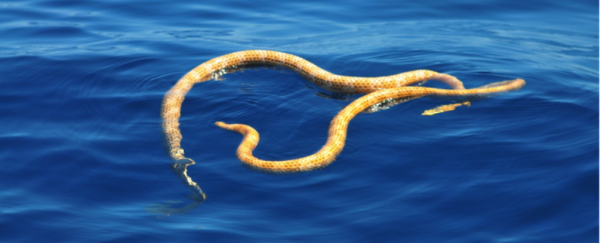Two striking sea snakes have been spotted drifting off the coast of Western Australia, more than 15 years after the species was declared extinct. These bright yellow short nosed sea snakes (Aipysurus apraefrontalis) vanished from their natural habitat in the Timor Sea between 1998 and 2002, only to reappear in full view of a park ranger this month.
"We were blown away, these potentially extinct snakes were there in plain sight, living on one of Australia's natural icons, Ningaloo Reef," said one of the researchers behind the discovery, Blanche D'Anastasi from James Cook University (JCU). "What is even more exciting is that they were courting, suggesting that they are members of a breeding population."
Western Australia Parks and Wildlife Officer, Grant Griffin, managed to photograph the brightly coloured pair of short nosed sea snakes and sent the image to JCU for identification.
These small, fully aquatic snakes appear to have a very limited habitat - before this discovery, it was thought they were restricted to the warm waters of the remote Ashmore Reef, located about 840 km west of Darwin in the Northern Territory. This sea snake hotspot boasts one on the world's richest sea snake communities, but numbers have been dwindling in recent years.
Some of its former inhabitants might be making their way elsewhere in the ocean, because about 1,700 km south of Ashmore reef, the researchers identified another very rarely seen species - the critically endangered leaf scaled sea snake (Aipysurus foliosquama) - foraging in the seagrass beds of Shark Bay.
"We had thought that this species of sea snake was only found on tropical coral reefs. Finding them in seagrass beds at Shark Bay was a real surprise," says D'Anastasi.
Back in 2013, Ben Collins at ABC News reported the alarming shift in sea snake populations in Ashmore Reef, with researchers noting how commonly sighted species started to dwindle before their eyes. Vimoksalehi Lukoschek from the Centre of Excellence for Coral Reef Studies at JCU said at the time:
"In '73 there were up to 45 snakes seen per day and about eight or nine species. And then in 2002 when I was there we only saw 20 snakes a day and only four species. And in 2010 we saw a grand total of just 45 snakes over a 10-day period, and essentially just one species.
So the message, I guess, from that is that there's been a massive and unprecedented decline in the diversity and abundance of sea snakes at Ashmore Reef."
While the decline is alarming, the fact that D'Anastasi and her team now have evidence of two critically endangered species living outside of Ashmore Reef means that by further studying them, they can get better understanding of where they've been migrating to.
"Many of the snakes in this study were collected from prawn trawl by-catch surveys, indicating that these species are vulnerable to trawling," Lukoschek said in a university press release. "Clearly we need to identify the key threats to their survival in order to implement effective conservation strategies if we are going to protect these newly discovered coastal populations."
The sightings have been published in Biological Conservation.
James Cook University is a sponsor of ScienceAlert. Find out more about their research.
